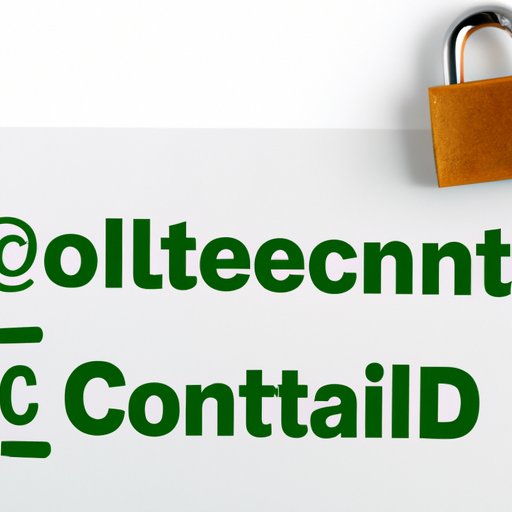
I. Introduction
Email is one of the most popular communication channels for personal and professional use. However, it’s essential to ensure that your emails are protected from cybercriminals and other malicious entities. In this article, we will guide you through sending secure emails in Outlook with the help of built-in features and third-party add-ins.
II. Step-by-Step Guide
To start sending secure emails in Outlook, you need to follow these simple steps:
Step 1: Open a new email in Outlook
Click on the “New Email” button located in the top-left corner of your screen.
Step 2: Enable encryption
In the “Options” group in the “Ribbon,” click on the “Encrypt” button. This will encrypt the email with a digital signature, so only the recipient can read the message.

Step 3: Add a recipient
In the “To” field, add the recipient’s email address using Outlook’s autocomplete feature or manually enter the address.
Step 4: Add a subject and message
In the “Subject” field, add a descriptive subject line for the email. In the message body, add your message text as usual.
Step 5: Send the email
Click on the “Send” button to send your secure email in Outlook.
After sending the email, you can verify that the email is secure by noticing the closed lock icon beside the recipient’s name. It means that the email is encrypted and secure.
III. Best Practices
To ensure maximum security, follow our best practices when sending secure emails in Outlook:
Use the BCC field
Use the BCC field to hide the recipient’s email addresses from other recipients, so it remains confidential.
Password-protect attachments
Password-protect any confidential attachments you send. Please ensure you don’t send the password in the same email. Use a different communication channel to send it securely.
Use secure communication channels
Use a secure channel like a VPN or a secure wireless network when sending emails. It prevents someone from intercepting your email or accessing your email account.
IV. Common Mistakes
Here are some common mistakes people make when sending secure emails in Outlook:
Ignoring encryption
Encryption is a vital feature for ensuring email security, but people often overlook this step. If you don’t enable encryption, your email can be intercepted, read and altered.
Sending sensitive information through email
Even if you encrypt emails, you should not send sensitive information like social security numbers, passwords or financial information via email. It’s best to use a different form of communication.
V. Alternative Options
If Outlook’s built-in features are not sufficient for your security needs, you have other options:
ProtonMail
ProtonMail is an email service that provides end-to-end encryption. It encrypts all emails, requires no personal identifying information, and has a feature called “Self-Destruct,” allowing you to set an expiry date for your email.
Gmail
While Gmail is not inherently secure, it offers an add-in called “Gmail Confidential mode,” which provides end-to-end encryption, control over the recipient’s ability to forward, copy and print messages, and message expiration settings.
VI. Third-Party Tools
Third-party tools can help you increase the security level of your Outlook email. Here are some options:
Tutanota
Tutanota is an encrypted email service that offers end-to-end encryption for all emails and is HIPAA and GDPR compliant.
Boomerang
Boomerang is an add-in for Outlook that has features like prioritizing emails, automatic emailing, and a feature called “Respondable,” which helps you write emails that are more likely to receive a quick response.
VII. Outlook Add-Ins
Outlook’s add-ins allows you to customize the email experience and add additional security features. Some popular add-ins are:
Docusign
Docusign is a secure digital signature add-in that provides authentication, encryption and integrity of signed documents.
SendSecure
SendSecure is an add-in that encrypts emails and attachments, prevents copying, and provides a secure messaging portal to share and collaborate on sensitive documents.
VIII. Encryption Explained
Email encryption uses public-key encryption technology to encrypt emails, ensuring that only the recipient can read the message. The email metadata, such as the sender’s name, subject, and recipients’ email addresses, remains unencrypted, but encrypted emails cannot be altered in transit.
IX. Conclusion
Secure email communication is essential in today’s world. Outlook’s built-in security features, combined with best practices, can help you ensure that your emails are secure and private. Consider exploring other email services and alternative options if your security needs are more involved.




